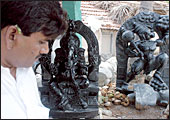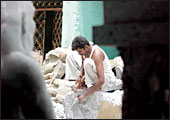|
If
you head out of Bangalore, take national Highway 7, drive north
by northeast towards Kolar (famous for its now-defunct gold mines)
and make a detour towards Malur from there, all you will see are
swaying paddy and ragi crops. Picturesque, but not very different
from a majority of the six lakh plus Indian villages, one might
say. That is true till you hit (and the chances are you will,
in all probability, miss) Shivarapatna, a remote village located
just a few hundred metres away from the main road. But ask and
you will be told where it is. Visitors from across the world do
that round the year. There's a reason for this.
As you enter the village, you are greeted
by the delicate sound of hammers and mallets (called ulli and
sutthi in the local lingo) chipping away at granite or marble
blocks. Scores of shilpis (sculptors) are bent over their tools
in their respective front yards, carving images of gods, goddesses
and mortals, just as their forebears had done for centuries. All
the 180 families in the village are connected to this trade in
one way or the other. Statues of Lord Venkateshwara, Lord Ganesh,
Goddess Lakshmi and B.R. Ambedkar are in various stages of completion.
 |
| Shivarapatna: A village like no other |
Welcome to Shivarapatna, the village of sculptors.
Shankarnarayana Charya is a 14th generation
sculptor and winner of numerous awards, including the President's
Medal. His small house is filled with medals, citations and certificates
from the central and state governments and from satisfied clients.
"My statues have been shipped to Ichigan (Michigan), Sanpaddru
(San Pedro) and Glassugu (Glasgow)," he says proudly. Idols
made in this village adorn numerous Hindu temples in the US, UK,
Germany France and Australia. Adds S.B. Nanjundacharya, an octogenarian
who still spends six hours every day chipping away at stone: "Most
of us are descendants of Amara Shilpi (immortal architect) Jakanchari,
who designed the world famous (13th century) temples in Belur
and Halebid. Sculpting runs in our blood."
 |
| Petty profits: Low returns are making
this profession unattractive for villagers |
 |
| Age-old legacy: All the 180 families
in the village are engaged in carving images of gods, goddesses
and mortals |
|
|
| Padmanabhacharya: Where are the profits? |
That is almost literally true. Children in
the village are initiated into Shilpa Shastra, the ancient Indian
art of architecture, design and sculpture, at the age of five.
They begin by sketching and graduate to full time sculpting only
after 10-15 years of rigorous training. "Shilpa Shastra teaches
you all about proportions; say, if the face is of a particular
size, then the nose, eyes, lips and ears have to be of a particular
dimension. Once a person masters this, the rest just falls into
place," he says. Adds Nanjundacharya's son, S.N. Tyagarajacharya:
"Initially, we copy and emulate our elders; later, as one
matures and picks up the finer aspects of the art, one also develops
an individual style." Every family has its distinctive secrets
which are guarded fiercely and handed down from generation to
generation. "I won't even teach my son-in-law some of the
tricks of the trade; those are reserved for my son," says
Kumar Acharya, a veteran carver.
Statues are usually carved out of Krishna
Shila (black granite) and Balapada Kallu (soap stone) though marble
and Kempa Kallu (red granite from Jaipur) are also used. The most
popular and in-demand statues: Hindu gods and goddesses, Ambedkar,
Mahatma Gandhi and Jawaharlal Nehru. "All we need is a photograph
of the leader or a replica of a statue," informs Nanjundacharya.
But in spite of the demand for their statues
and the high prices they command-in India a lifesize idol can
cost Rs 15-20 lakh at the retail end; abroad, this rises to $50,000-80,000
or Rs 23-36.8 lakh, (prices vary according to the stone and the
amount of carving that needs to be done)-most of these sculptors
are very poor. Says S.B. Padmanabhacharya, a Karnataka state award
winner: "Government support is non-existent. And middlemen
take away all the profits. I don't want my grandchildren to become
sculptors. They should study and work in air-conditioned offices."
Most sculptors also suffer from diseases like piles and lung infection-a
consequence of the long hours they spend sitting in difficult
postures and inhaling stone dust. "We work with gods and
others pray to the idols we make, but God does not seem to hear
our prayers," adds Padmanabhacharya.
|








